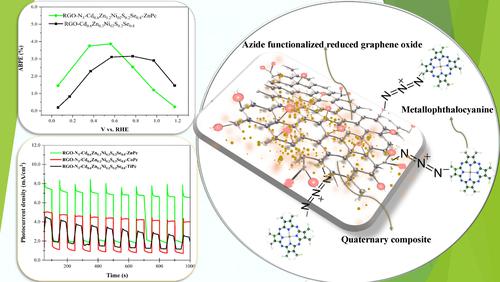当前位置:
X-MOL 学术
›
ChemElectroChem
›
论文详情
Our official English website, www.x-mol.net, welcomes your feedback! (Note: you will need to create a separate account there.)
Metal Phthalocyanine Sensitized Photoelectrochemical Cell Assembling with Azide‐Functionalized Reduced Graphene and Quaternary Metal Chalcogenide Composites
ChemElectroChem ( IF 4 ) Pub Date : 2024-03-27 , DOI: 10.1002/celc.202400018 Deniz Ezgi Varol 1 , Özlem Uğuz Neli 1 , Özlem Budak 1 , Bahadır Keskin 2 , Atıf Koca 1
ChemElectroChem ( IF 4 ) Pub Date : 2024-03-27 , DOI: 10.1002/celc.202400018 Deniz Ezgi Varol 1 , Özlem Uğuz Neli 1 , Özlem Budak 1 , Bahadır Keskin 2 , Atıf Koca 1
Affiliation

|
Here, photoelectrodes of photoelectrochemical (PEC) cells consisting of azide functionalized reduced graphene oxide (GO‐N3 ) and quaternary metal chalcogenide (CdZnNiSSe) composites sensitized with metal phthalocyanines (MPc, M: Co, Zn, Ti) are developed and then tested in hydrogen evolution reaction (HER). CdZnNiSSe/RGO‐N3 composite is deposited on an indium tin oxide (ITO) electrode through a facile electrodeposition technique and ITO/CdZnNiSSe/RGO‐N3 photoelectrode is constructed. Then, MPcs bearing terminal alkyne groups are connected to RGO‐N3 via the copper(I)‐catalyzed azide‐alkyne cycloaddition (click chemistry) technique to produce ITO/CdZnNiSSe/RGO‐N3 ‐MPc structures. Decoration of ITO/CdZnNiSSe/RGO‐N3 with MPcs is proposed to improve the charge transfer capability of the photoelectrode due to wide light absorption of MPcs from UV toward the IR region of the light spectrum. PECHER responses indicate that among the photoanodes bearing ZnPc, CoPc, and TiOPc, ITO/CdZnNiSSe/RGO‐N3 ‐ZnPc electrode exhibits the highest PECHER performance owing to the suitability of band structure of ZnPc. Sensitizing ITO/CdZnNiSSe/RGO‐N3 with ZnPc increases the photocurrent density from 5.0 to 7.3 mA cm−2 at 0.8 V vs. RHE and the applied bias photon to current efficiency (ABPE) enhances from 3.18 % to 3.87 %. This study provides a new approach for increasing the performance of photoanodes via sensitization with MPcs in photoelectrochemical hydrogen evolution processes for future applications.
中文翻译:

叠氮化物官能化还原石墨烯与四元金属硫属化物复合材料组装金属酞菁敏化光电化学电池
在这里,光电化学(PEC)电池的光电极由叠氮化物功能化的还原氧化石墨烯(GO-N)组成3 )和金属酞菁(MPc,M:Co,Zn,Ti)敏化的四元金属硫属化物(CdZnNiSSe)复合材料被开发出来,然后在析氢反应(HER)中进行测试。镉锌镍SSe/RGO-N3 通过简单的电沉积技术和 ITO/CdZnNiSSe/RGO-N 将复合材料沉积在氧化铟锡 (ITO) 电极上3 构建光电极。然后,带有末端炔基的 MPcs 连接到 RGO-N3 通过铜(I)催化叠氮化物-炔环加成(点击化学)技术生产ITO/CdZnNiSSe/RGO-N3 ‐MPc 结构。 ITO/CdZnNiSSe/RGO-N 修饰3 由于 MPcs 从紫外到红外光谱区域的广泛光吸收,建议使用 MPcs 来提高光电极的电荷转移能力。 PECHER 响应表明,在带有 ZnPc、CoPc 和 TiOPc 的光电阳极中,ITO/CdZnNiSSe/RGO-N3 ‐由于 ZnPc 的能带结构的适应性,ZnPc 电极表现出最高的 PECHER 性能。敏化 ITO/CdZnNiSSe/RGO-N3 ZnPc 将光电流密度从 5.0 mA cm 增加到 7.3 mA cm−2 相对于 RHE 的电压为 0.8 V 时,所施加的偏置光子电流效率 (ABPE) 从 3.18% 提高到 3.87%。这项研究提供了一种通过在光电化学析氢过程中使用 MPc 进行敏化来提高光电阳极性能的新方法,以供未来应用。
更新日期:2024-03-27
中文翻译:

叠氮化物官能化还原石墨烯与四元金属硫属化物复合材料组装金属酞菁敏化光电化学电池
在这里,光电化学(PEC)电池的光电极由叠氮化物功能化的还原氧化石墨烯(GO-N)组成



























 京公网安备 11010802027423号
京公网安备 11010802027423号